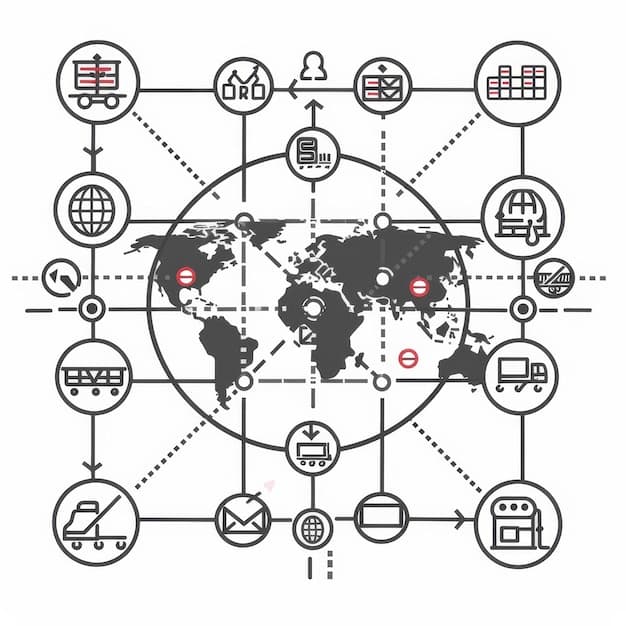Supply Chain Disruptions: Adapting & Minimizing Losses in 2025

Businesses globally are proactively addressing supply chain disruptions by implementing diverse strategies like diversification of suppliers, enhanced technology adoption, and localized production aiming to build resilient and agile networks that can minimize economic losses and ensure operational continuity by 2025.
In an increasingly interconnected yet volatile global economy, the resilience of supply chains dictates the survival and success of businesses. The landscape of commerce is continually shaped by unforeseen events, making a deep understanding of Supply Chain Disruptions: How Businesses Are Adapting and Minimizing Losses in 2025 not just pertinent, but essential for strategic planning and long-term sustainability.
Understanding the Evolving Nature of Supply Chain Disruptions
The trajectory of global business has been significantly impacted by a series of unprecedented events over the past few years, from geopolitical tensions and trade wars to pandemics and climate change-induced disasters. These incidents have laid bare existing vulnerabilities within intricate global supply chain networks, prompting a necessary re-evaluation of established practices. Businesses are now acutely aware that disruptions are not merely exceptions but an inherent risk factor that demands continuous, proactive management.
The nature of these disruptions has also evolved. While traditional disruptions might have been localized to a specific region or sector, modern challenges often cascade across multiple industries and geographies, creating a domino effect. This interconnectedness means that a hiccup in one part of the world, say a port closure or a factory shutdown, can have ripple effects that are felt thousands of miles away, impacting everything from raw material availability to final product delivery.
The Shift from Efficiency to Resilience
For decades, supply chain optimization largely focused on achieving maximum efficiency and cost reduction, often through lean inventory strategies and single-sourcing from low-cost regions. While this approach certainly yielded significant cost savings, it inadvertently created systems that were highly efficient but remarkably brittle when faced with unexpected shocks. The current imperative is to pivot from this strict efficiency model towards one that prioritizes resilience and adaptability.
This shift involves a holistic rethinking of how supply chains are designed, managed, and monitored. It encompasses investing in robust risk management frameworks, fostering stronger collaborative relationships with partners, and embracing technological advancements to enhance visibility and responsiveness. The goal is not to entirely eradicate disruptions – an impossible feat – but to build systems that can absorb shocks, recover swiftly, and even emerge stronger from adversity.

Enhanced Supply Chain Visibility and Data Analytics
One of the most critical lessons learned from recent disruptions is the paramount importance of real-time supply chain visibility. Many companies operated with limited insight into their extended supply networks, often only fully understanding the first or second tier of their suppliers. This lack of deep visibility made it nearly impossible to anticipate or react effectively when issues arose further upstream or downstream.
Forward-thinking businesses are now heavily investing in technologies that provide comprehensive, end-to-end visibility. This includes everything from IoT sensors tracking goods in transit to advanced analytics platforms aggregating data from multiple sources. The aim is to create a digital twin of the physical supply chain, offering a real-time, granular view of inventory levels, production schedules, transportation routes, and potential bottlenecks.
Leveraging Big Data and AI for Predictive Insights
Beyond mere visibility, the true power lies in leveraging big data and artificial intelligence (AI) to transform raw data into actionable insights. AI algorithms can analyze vast datasets, including historical disruption patterns, weather forecasts, geopolitical news, and economic indicators, to predict potential disruptions before they fully materialize. This predictive capability allows businesses to take proactive measures, such as rerouting shipments, activating alternative suppliers, or adjusting production schedules, thereby significantly mitigating potential losses.
Key advancements in this area include:
- Predictive Analytics Platforms: Utilizing machine learning to forecast demand fluctuations, identify potential supplier failures, and anticipate logistical bottlenecks based on various data points.
- AI-Powered Risk Assessment: Continuously monitoring global events and automatically flagging potential risks to specific supply chain nodes or regions.
- Digital Twins: Creating virtual models of physical supply chains, enabling simulations of disruption scenarios and testing of mitigation strategies in a controlled environment.
The strategic implementation of these technologies is not just an operational upgrade; it’s a fundamental shift towards a more intelligent, responsive, and resilient supply chain ecosystem.
Diversification of Suppliers and Production Geographies
The reliance on single-source suppliers or concentration of production in a few specific geographic regions has proven to be a significant vulnerability. When these single points of failure are compromised, the entire supply chain can grind to a halt. Recognizing this, businesses are aggressively pursuing strategies to diversify their supplier base and decentralize their manufacturing operations.
This diversification doesn’t simply mean adding more suppliers; it often involves establishing relationships with vendors in different geographical locations, with varying risk profiles. For instance, a company previously sourcing all its components from one country might now engage suppliers in two or three different regions, ensuring continuity of supply even if one region faces a severe disruption.
Nearshoring, Reshoring, and Friendshoring Initiatives
The trend towards globalized, offshore manufacturing driven by cost efficiencies is being re-evaluated. Many companies are now exploring “nearshoring” – bringing production closer to home markets – or “reshoring” – relocating production back to the home country. These strategies, while potentially increasing production costs, significantly reduce lead times, transportation risks, and exposure to geopolitical instability.
Another emerging concept is “friendshoring,” which involves sourcing from or locating production in countries deemed geopolitically stable and aligned. This reduces reliance on regions with high geopolitical risk, prioritizing supply chain security over pure cost optimization. These strategic geographical shifts are part of a broader effort to build more secure and less volatile supply networks.
- Reduced Geopolitical Risk: Less exposure to trade disputes, sanctions, or international conflicts impacting specific regions.
- Shorter Lead Times: Quicker delivery of goods and components, improving responsiveness to demand changes.
- Enhanced Control: Greater oversight over manufacturing processes and quality control when operations are closer to home.
- Supply Continuity: Multiple operational hubs ensure that production can continue even if one region is affected by a natural disaster or other disruption.
The overarching goal is to create a multi-pronged approach that mitigates the risk of concentrated failure points, ensuring a more robust and adaptive supply chain for the future.
Building Stronger Supplier Relationships and Collaboration
Beyond simply having multiple suppliers, the quality of relationships with these partners is becoming increasingly vital. In times of crisis, strong, collaborative relationships built on trust and transparency can be the difference between supply chain collapse and continued operation. Businesses are moving away from purely transactional interactions towards more strategic partnerships.
This involves sharing information openly, collaborating on demand forecasting, co-investing in new technologies, and even jointly developing risk mitigation strategies. When suppliers feel like true partners, they are more likely to prioritize the needs of their clients during challenging times, offering flexibility and innovative solutions.
Information Sharing and Joint Planning
Effective collaboration hinges on seamless information sharing. Companies are establishing digital platforms that enable real-time data exchange with key suppliers, including demand forecasts, inventory levels, production capacities, and disruption alerts. This shared visibility allows for joint planning and prompter responses to evolving conditions.
For example, if a company anticipates a surge in demand, sharing this information early with a trusted supplier allows them to ramp up production proactively, avoiding potential stockouts. Conversely, if a supplier faces a production issue, immediate notification enables the client to seek alternative sources or adjust their own schedules. A collaborative ecosystem transforms potential crises into manageable challenges.
Investing in Workforce Preparedness and Agility
Technology and diversified strategies are crucial, but the human element remains at the core of effective supply chain management. A well-trained, adaptable, and informed workforce is essential for navigating the complexities of modern disruptions. Businesses are recognizing the need to invest in continuous learning and skill development for their supply chain professionals.
This includes training in data analytics, risk management, digital tools, and critical thinking. An agile workforce can quickly assess evolving situations, make informed decisions under pressure, and implement new strategies effectively. Furthermore, fostering a culture of adaptability and continuous improvement within the supply chain team is paramount.
Cross-functional Teams and Scenario Planning
To enhance agility, many companies are forming cross-functional teams that bring together expertise from various departments, including procurement, logistics, finance, IT, and sales. These teams can provide a holistic view of potential impacts and collaborate on comprehensive response plans. Regular scenario planning and simulation exercises also help prepare teams for different types of disruptions.
By simulating events such as natural disasters, cyberattacks, or geopolitical crises, companies can:
- Identify Gaps: Uncover weaknesses in existing response plans and capabilities.
- Refine Protocols: Develop clear, step-by-step procedures for various disruption scenarios.
- Enhance Decision-Making: Equip teams with the experience to make quick, effective decisions under pressure.
This proactive approach to talent development and organizational design ensures that the human capital within the supply chain is as resilient and adaptable as the networks themselves.

The Role of Automation and Advanced Robotics
Automation and robotics are no longer futuristic concepts but essential components of a modern, resilient supply chain. These technologies can significantly enhance efficiency, reduce human error, and provide greater flexibility in operations, particularly in warehousing, logistics, and manufacturing.
Automated warehouses, for instance, can operate with minimal human intervention, reducing the risk of operational shutdowns due to labor shortages or health crises. Robotic process automation (RPA) can streamline administrative tasks, improving data accuracy and speeding up decision-making within the supply chain.
Leveraging Digital Platforms and AI-Powered Automation
Beyond physical robots, the scope of automation extends to digital platforms and AI-powered systems that manage complex processes. These include automated inventory management systems that dynamically adjust stock levels based on real-time demand and supply signals, and AI-driven route optimization tools that adapt to changing traffic or weather conditions.
The integration of these automated solutions leads to:
- Increased Throughput: Faster processing and movement of goods.
- Reduced Manual Errors: Minimized incidence of human mistakes in data entry or logistics.
- Enhanced Responsiveness: Ability to quickly adjust operations to unexpected changes.
- Cost Savings: Long-term reduction in labor costs and operational inefficiencies.
By embracing these advanced technologies, businesses are not only optimizing their supply chain operations but also building an inherent level of resilience that allows them to withstand and adapt to various forms of disruption, ensuring continued market competitiveness in the years to come.
Navigating Regulatory Landscapes and Ethical Sourcing
The increasing complexity of global supply chains is matched by an expanding web of national and international regulations. Businesses must navigate a myriad of compliance requirements related to trade, environmental standards, labor practices, and data privacy. Failure to adhere to these regulations can result in severe penalties, reputational damage, and significant operational disruptions.
Beyond mere compliance, there is a growing emphasis on ethical sourcing. Consumers, investors, and regulators are increasingly demanding transparency and accountability regarding the social and environmental impact of supply chain practices. This includes ensuring fair labor conditions, minimizing environmental footprints, and verifying the origins of materials. Businesses that can demonstrate a commitment to ethical sourcing not only mitigate reputational risks but also build stronger brand loyalty and investor confidence. This holistic approach to supply chain management considers not just economic efficiency, but also societal and environmental responsibilities, thereby building a more robust and future-proof operation.
| Key Adaptation | Brief Description |
|---|---|
| 📊 Enhanced Visibility | Utilizing real-time data and AI to track goods and predict disruptions across the entire supply chain. |
| 🌍 Diversified Sourcing | Spreading manufacturing and supplier bases across different geographies to reduce single-point failures. |
| 🤝 Stronger Partnerships | Building collaborative and transparent relationships with suppliers for joint risk mitigation. |
| 🤖 Automation & Robotics | Implementing advanced technologies in warehouses and logistics to boost efficiency and resilience. |
Frequently Asked Questions About Supply Chain Resilience
In 2025, primary causes continue to be geopolitical instability, climate change-related events like extreme weather, cyberattacks, and lingering effects of global health crises. Economic volatility, including inflation and energy costs, also plays a significant role, impacting raw material availability, labor, and transportation, thus creating a complex web of interconnected challenges for businesses worldwide.
AI significantly enhances supply chain resilience by providing predictive analytics, enabling businesses to anticipate potential disruptions before they occur. It optimizes inventory management, identifies alternative routes and suppliers in real-time, and automates complex decision-making processes. This leads to faster, more informed responses, minimizing delays and financial losses during unforeseen events and optimizing overall operational efficiency and adaptability within the supply chain network.
“Friendshoring” refers to relocating supply chain operations to, or sourcing from, countries with strong political and economic alliances. It’s gaining traction due to increased geopolitical tensions and concerns over supply chain security. This strategy aims to reduce reliance on potentially unstable or adversarial regions, prioritizing reliability and geopolitical alignment over pure cost optimization. It builds more robust, trustworthy supply networks.
Small businesses can adapt by diversifying their supplier base, focusing on building strong relationships with local or regional suppliers, and maintaining buffer stock where feasible. Embracing digital tools for better inventory management and adopting flexible logistical solutions are also key. They should prioritize critical components, create contingency plans, and collaborate with industry peers to share resources and information, fostering collective resilience.
Sustainability is becoming integral to future supply chain strategies, moving beyond mere compliance to a strategic imperative. It involves ethical sourcing, reducing carbon footprints, and promoting circular economy principles. Sustainable practices not only enhance brand reputation and consumer trust but also often lead to operational efficiencies and reduced long-term risks. Furthermore, supply chains designed with sustainability in mind are often inherently more resilient to environmental and social disruptions.
Conclusion
The persistent challenges posed by global events have irrevocably transformed the landscape of supply chain management. Businesses are no longer just reacting to disruptions but are proactively building strategies that prioritize resilience, adaptability, and technological integration. From enhancing visibility with AI and diversifying supplier networks to fostering collaborative relationships and investing in workforce preparedness, the aim is to create future-proof supply chains. These strategic shifts are not merely about minimizing losses in 2025; they are about laying the groundwork for sustained growth and competitiveness in an unpredictable global economy, ensuring that businesses can not only survive but thrive amidst constant change.





